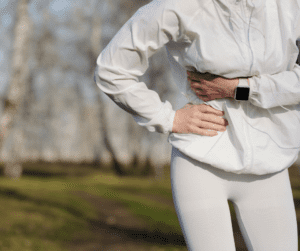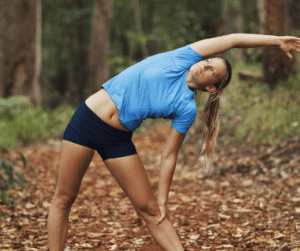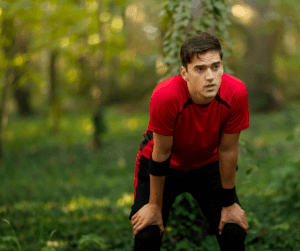
Side stitches commonly occur during physical exercise, so if you’re a runner or someone who engages in prolonged physical activities then chances are you’ve felt the familiar ache of a stitch on either side of your abdomen.
Stitches, or exercise-related transient abdominal pain (ETAP), are somewhat of a mystery as there is no precise or proven cause and there are multiple different theories surrounding the topic.
Side stitches can range from a dull ache in your abdominal cavity or cramping feeling to a sharp, stabbing pain or pulling sensation below one’s rib cage on either side of the body.
Let’s try our best to unfold the mystery of side stitches…
Are Side Stitches Caused By a Spasm In The Diaphragm?
Some say that stitches are the result of a spasm in the diaphragm due to increased breathing during exercise, while others theorize that they are caused by increased blood flow to your internal organs, like your spleen and liver.
This could cause temporary hepatomegaly or portal hypertension which restricts blood flow to the rest of the body and thus causes some abdominal pain around the liver.
While those are two of the most common theories surrounding what causes stitches, there are many more so keep reading.
If you’d like to understand the science behind a side stitch then a study (Authored by Morton DP, Callister R) that was published in the Journal of Science and Medicine in Sport is a fascinating read.
Firstly, let’s unpack what exactly causes a side stitch…
What Causes Side Stitches?
No one is 100% sure of what causes side stitches part of the reason why this is the case is that they are not site-specific.

Some people get stitches up around the collarbone or just under the collarbone area, other people get it kind of in the mid-abdominal region between the ribs, and then the most common is a stitch just underneath the diaphragm.
When it’s in the abdominal area, or just below the diaphragm or in the stomach, then the culprit normally is the diaphragm itself.
So you would trace it back to either your breathing or how full your stomach is.
Side stitches when running may be the result of a diaphragm spasm which, like any muscle, can fatigue during exercise.
If your diaphragm is not used to the extra stress of exercise or if you’re pushing yourself too hard, you are more likely to experience a side stitch.
People new to running, or any other cardio activity, are more likely to get side stitches because their bodies aren’t used to prolonged aerobic activity.
Another leading theory is that as your rate increases during exercise it forces more red blood cells into the liver, which can cause temporary live enlargement (hepatomegaly) or high blood pressure around the liver and portal vein (portal hypertension).
These conditions can restrict the blood flow from the liver to the portal vein and therefore slow down the blood flow to the rest of the body.
This is why many people will feel a side stitch on their right-hand side around the liver.
Your breathing patterns could also be what is causing the discomfort. Shallow breathing could also cause side stitches as you need to breathe deeper when you run so that your muscles get enough oxygen.
One of the most well-known causes of side stitches is eating a big meal or drinking a sugary sports drink before you go for a run.

How To Prevent Side Stitches
Changing your breathing and slowing it down, making it deeper… will often help side stitches, you can also apply pressure to that muscle with either your fingers or the palm of your hand.
Some people hunch over and it serves the same purpose as applying pressure.
Walking often reduces the pain from a side stitch and in that instance where walking does reduce the cramping, then I do feel that often changing the breathing pattern will definitely help.
It will be worth it to do some belly breathing (as you breathe, breathe in your stomach and out of your stomach), this will help ease the pain and relax the muscles.
There are 3 things you can do to prevent a side stitch while running:
- Warm up properly
- Breathe deeper
- Eat properly before your run
Let’s dig into each of these in a bit more detail…
Warm-Up Properly
It is always important to make sure you warm up your muscles before you do any sort of exercise.
Going from 0 to 100 with no warm-up causes irregular breathing and puts a lot of strain on your muscles. Warming up helps to get your muscles ready to go so that you can exercise for longer without getting a side stitch or cramping.
Breathe Deeper
Make sure you breathe deeply when you exercise so that you get enough oxygen to your muscles. Your muscles need oxygen to work properly so shallow breathing can cause your muscles to fatigue quicker and cramp up. Inhaling deeply and fully exhaling while running can help prevent side stitches.
The rhythm of your breathing can also cause a spasm, Research shows that the best way to breathe while running is to take deeper, longer breaths and to include rhythmic breathing.
Eat Properly Before Your Run
What you eat and how long you wait in between eating and exercising both contribute to you your chances of getting a side stitch. If you’re still digesting some food when you start your exercise, less blood flows to the diaphragm which can cause spasms.
Certain foods take longer to digest so should be avoided before you exercise or head out on your run. So don’t eat food that is high in fat or fiber and avoid sugary drinks or sports drinks as well.
If you are unsure about which foods are more likely to trigger stitches, you can keep a log of what you eat and drink before your runs and then track when you get stitches to recognize which food is a possible trigger.
What To Do When a Side Stitch Strikes During a Run
- Slow Down
- Stretch
- Breathe
Let’s have a more detailed look at each of there…
- Slow Down
When you get a side stitch while running or exercising then slow down and walk until the pain goes away. Putting your hand over the area and breathing deeply will help to alleviate the pain as well.
- Stretch
Stretching your abdominal muscles by reaching up with one hand while bending to the side of the stitch can help get your blood flowing and stretch out any cramping muscles that may be causing the side stitch.
- Breathe
If you get a stitch, try concentrating on your breathing and make sure you breathe in deeply and exhale fully. This will help increase the oxygen levels in your muscles so that they can function normally.
Now that you know how to handle your side stitch if it appears on a run – Let’s see if you should continue your run thereafter…
Can You Continue Running With a Side Stitch?
While it is recommended to slow down to a walk if you experience a side stitch, you can continue to run with a stitch.
Side stitches can range from a mild ache to a painful, sharp, stabbing sensation so whether you want to carry on running with a side stitch is dependent on you and how much pain you’re in.

If the pain is mild you can continue running but you should try to focus on your breathing and get into a pattern of deep breathing while you run so that you get enough oxygen to your muscles which will help to ease the stitch.
As you experience a more sharp and more painful side stitch, it is recommended that you slow your pace down to a walk or a jog if you don’t want to walk, until the pain subsides.
When you get a side stitch while running one of the best things you can do to get rid of it is to focus on your breath, this is what you should do…
How To Breathe When Running
The number one question we get asked is if you should be breathing through your nose or your mouth while running…
We get asked this question a lot because people are trying to maximize the amount of oxygen that they’re getting into their system, the real limiting factor isn’t necessarily around how much oxygen you’re getting in it’s more based on what’s going on at a cellular level and how that oxygen is being utilized.
Essentially this is saying that, even if you learn how to breathe better, it may not improve your running.
You need to improve your exercise efficiency to become a better runner.
Biologically, your nose is there for you to breathe. The reason for that is there are nasal hairs so that when you’re breathing in cold air – it warms up the air before going into your lungs.
This is why we use our noses to breathe when we’re not running.
When we are running we need to get more air in which is why we end up using our mouths and noses.
A few studies have been done on which is better… they’re not great studies because they use very small populations, so the science is pretty much out on whether nasal or oral breathing is better.
Very often I find that it’s a personal choice as to what you prefer to use but predominantly you are going to go for what is biologically your default, which will very often be the nose and perhaps complement it with a bit of oral breathing at the same time.
Some running breathing strategies include rhythmic breathing. The idea of this is to get our inhalation and exhalation to time with our running stride.
Most of us find ourselves breathing (whether it’s a conscious or an unconscious action) and exhaling on two strides and then inhaling on two strides… which is even-sided and what ends up happening with every foot strike we make on the ground it’s a jolt to our body, so we’re almost forced into a bit of an exhalation.
By doing this we tend to exhale on the same side of our body the whole time and there has been a little bit of science that has pointed to a relatively small risk of injury by breathing on the same side every time or rather exhaling on the same side every time and that could come down largely to our posture and how we are handling ourselves and keeping ourselves upright every time we exhale.
The idea of rhythmic breathing is to mix that up a bit where we inhale for three strides exhale for two strides inhale on three strides exhale on two strides … So the idea here is that we are exhaling on alternating sides of the body.
Touching back on belly breathing… It’s something that you can practice while you’re sitting at home or at your desk in the office.

By doing belly breathing, you’re trying to engage your diaphragm to open up more of the lung capacity, to allow more air into the lungs. When you breathe in you should feel your stomach expand and when you breathe out everything contracts so that’s the idea.
Runners Tip: You can also use breathing techniques to help relax the pelvic floor, which is vital for anyone struggling with pelvic floor issues.
To see more ways to breathe correctly while running: Click Here
Now that you know what causes side stitches, how to prevent side stitches, and how to cure side stitches – Let’s see how bad the damage really is…
Can a Side Stitch Cause Permanent Damage?
Side stitches do not cause any permanent damage to your body, muscles, or organs.
They are a temporary condition caused by changes in blood flow, blood pressure, or spasms in the diaphragm, and they usually only last a few minutes.
Once your blood flow normalizes and your muscles start functioning normally again, your stitch will go away and you can continue to run or exercise as you please.
While stitches may be a nuisance, they are ultimately harmless and will not cause any permanent damage.
If you have severe side pain accompanied by a fever and abdominal swelling, see a medical professional immediately as those are symptoms of something more serious.




Comments are closed.